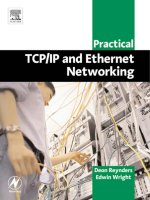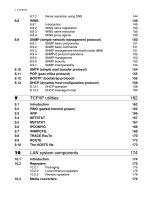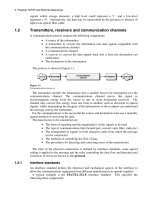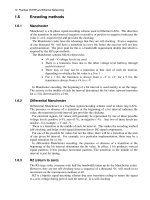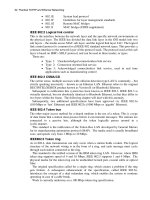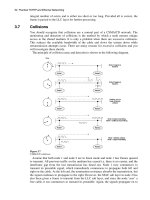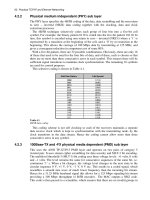Practical TCP/IP and Ethernet Networking- P41 potx
Bạn đang xem bản rút gọn của tài liệu. Xem và tải ngay bản đầy đủ của tài liệu tại đây (337.92 KB, 5 trang )
182 Practical TCP/IP and Ethernet Networking
Figure 10.6
Fast Ethernet hub interconnection
10.6 Switches
Ethernet switches are an expansion of the concept of bridging and are, in fact, intelligent
(self-learning) multi-port bridges. They enable frame transfers to be accomplished
between any pair of devices on a network, on a per-frame basis. Only the two ports
involved ‘see’ the specific frame. Illustrated below is an example of an 8 port switch,
with 8 hosts attached. This comprises a physical star configuration, but it does not operate
as a logical bus as an ordinary hub does. Since each port on the switch represents a
separate segment with its own collision domain, it means that there are only 2 devices on
each segment, namely the host and the switch port. Hence, in this particular case, there
can be no collisions on any segment!
In the sketch below hosts 1 & 7, 3 & 5 and 4 & 8 need to communicate at a given
moment, and are connected directly for the duration of the frame transfer. For example,
host 7 sends a packet to the switch, which determines the destination address, and directs
the package to port 1 at 10 Mbps.
Figure 10.7
8-Port Ethernet switch
LAN system components 183
If host 3 wishes to communicate with host 5, the same procedure is repeated. Provided
that there are no conflicting destinations, a 16-port switch could allow 8 concurrent frame
exchanges at 10 Mbps, rendering an effective bandwidth of 80 Mbps. On top of this, the
switch could allow full-duplex operation, which would double this figure.
10.6.1 Cut-through vs store-and-forward
Switches have two basic architectures, cut-through and store-and-forward. In the past,
cut-through switches were faster because they examined the packet destination address
only before forwarding the frame to the destination segment. A store-and-forward switch,
on the other hand, accepts and analyzes the entire packet before forwarding it to its
destination. It takes more time to examine the entire packet, but it allows the switch to
catch certain packet errors and keep them from propagating through the network. The
speed of modern store-and-forward switches has caught up with cut-through switches so
that the speed difference between the two is minimal. There are also a number of hybrid
designs that mix the two architectures.
Since a store-and-forward switch buffers the frame, it can delay forwarding the frame if
there is traffic on the destination segment, thereby adhering to the CSMA/CD protocol.
In the case of a cut-through switch this is a problem, since a busy destination segment
means that the frame cannot be forwarded, yet it cannot be stored either. The solution is
to force a collision on the source segment, thereby enticing the source host to retransmit
the frame.
10.6.2 Layer 2 switches vs layer 3 switches
Layer 2 switches operate at the data link layer of the OSI model and derive their
addressing information from the destination MAC address in the Ethernet header. Layer 3
switches, on the other hand, obtain addressing information from the network layer,
namely from the destination IP address in the IP header. Layer 3 switches are used to
replace routers in LANs as they can do basic IP routing (supporting protocols such as RIP
and RIPv2) at almost ‘wire-speed’; hence they are significantly faster than routers.
10.6.3 Full-duplex switches
An additional advancement is full-duplex Ethernet where a device can simultaneously
transmit AND receive data over one Ethernet connection. This requires a different
Ethernet NIC in the host, as well as a switch that supports full-duplex. This enables two
devices to transmit and receive simultaneously via a switch. The node automatically
negotiates with the switch and uses full-duplex if both devices can support it.
Full-duplex is useful in situations where large amounts of data are to be moved around
quickly, for example between graphics workstations and file servers.
10.6.4 Switch applications
High-speed aggregation
Switches are very efficient in providing a high-speed aggregated connection to a server or
backbone. Apart from the normal lower-speed (say, 10BaseT) ports, switches have a
high-speed uplink port (100Base-TX). This port is simply another port on the switch,
accessible by all the other ports, but features a speed conversion from 10 Mbps
to 100 Mbps.
184 Practical TCP/IP and Ethernet Networking
Assume that the uplink port was connected to a file server. If all the other ports (say,
eight times 10BaseT) wanted to access the server concurrently, this would necessitate a
bandwidth of 80 Mbps in order to avoid a bottleneck and subsequent delays. With a
10BaseT uplink port this would create a serious problem. However, with a 100Base-TX
uplink there is still 20 Mbps of bandwidth to spare.
Figure 10.8
Using a switch to connect users to a server
Backbones
Switches are very effective in backbone applications, linking several LANs together as
one, yet segregating the collision domains. An example could be a switch located in the
basement of a building, linking the networks on different floors of the building. Since the
actual ‘backbone’ is contained within the switch, it is known in this application as a
‘collapsed backbone’.
Figure 10.9
Using a switch as a backbone
LAN system components 185
VLANs and deterministic Ethernet
Provided that a LAN is constructed around switches that support VLANs, individual
hosts on the physical LAN can be grouped into smaller Virtual LANs (VLANs), totally
invisible to their fellow hosts. Unfortunately, the ‘standard’ Ethernet/ IEEE802.3 header
does not contain sufficient information to identify members of each VLAN; hence, the
frame had to be modified by the insertion of a ‘tag’, between the Source MAC address
and the type/length fields. This modified frame is known as an Ethernet 802.1Q tagged
frame and is used for communication between the switches.
Figure 10.10
Virtual LANs using switches
The IEEE 802.1p committee has defined a standard for packet-based LANs that
supports layer 2 traffic prioritization in a switched LAN environment. IEEE 802.1p is part
of a larger initiative (IEEE 802.1p/Q) that adds more information to the Ethernet header
(as shown in Fig 10.11) to allow networks to support VLANs and traffic prioritization.
Figure 10.11
IEEE 802.1p/Q modified Ethernet header
186 Practical TCP/IP and Ethernet Networking
802.1p/Q adds 16 bits to the header, of which three are for a priority tag and twelve for
a VLAN ID number. This allows for eight discrete priority layers from 0 (high) to 7 (low)
that support different kinds of traffic in terms of their delay-sensitivity. Since IEEE
802.1p/Q operates at layer II, it supports prioritization for all traffic on the VLAN, both
IP and non-IP. This introduction of priority layers enables so-called deterministic
Ethernet where, instead of contending for access to a bus, a source node can pass a frame
directly to a destination node on the basis of its priority, and without risk of any
collisions.
10.7 Routers
Unlike bridges and layer 2 switches, routers operate at layer 3 of the OSI model, namely
at the network layer (or, the Internet layer of the DOD model). They therefore ignore
address information contained within the data link layer (the MAC addresses) and rather
delve deeper into each frame and extract the address information contained in the network
layer. For TCP/IP this is the IP address.
Like bridges or switches, routers appear as hosts on each network that it is connected to.
They are connected to each participating network through an NIC, each with a MAC
address as well as an IP address. Each NIC has to be assigned an IP address with the same
NetID as the network it is connected to. This IP address allocated to each network is
known as the default gateway for that network and each host on the internetwork requires
at least one default gateway (but could have more). The default gateway is the IP address
to which any host must forward a packet if it finds that the NetID of the destination and
the local NetID do not match, which implies remote delivery of the packet.
A second major difference between routers and bridges or switches is that routers will
not act autonomously but rather have to be GIVEN the frames that need to be forwarded.
A host to the designated default gateway forwards such frames.
Protocol dependency
Because routers operate at the network layer, they are used to transfer data between two
networks that have the same Internet layer protocols (such as IP) but not necessarily the
same physical or data link protocols. Routers are therefore said to be protocol dependent,
and have to be able to handle all the Internet layer protocols present on a particular
network. A network utilizing Novell Netware therefore requires routers that can
accommodate IPX (Internet packet exchange) – the network layer component of
SPX/IPX. If this network has to handle Internet access as well, it can only do this via IP,
and hence the routers will need to be upgraded to models that can handle both IPX and
IP.
Routers maintain tables of the networks that they are connected to and of the optimum
path to reach a particular network. They then redirect the message to the next router along
that path.
10.7.1 Two-port vs multi-port routers
Multi-port routers are chassis-based devices with modular construction. They can
interconnect several networks. The most common type of router is, however, a 2-port
router. Since these are invariably used to implement WANs, they connect LANs to a
‘communications cloud’; the one port will be a local LAN port e.g. 10BaseT, but the
second port will be a WAN port such as X.25.
